
River Getaways in the West
Swim, raft, fish, kayak, or just splash around at nine Western waterways.

Rogue River in Grants Pass, Oregon
Rafters and river runners have reason to celebrate southern Oregon’s spring rains. Those drops help fill Lost Creek Lake, a reservoir that fuels the Rogue, the region’s premier source of river fun. Many Rogue rafting trips start at the Hog Creek Boat Ramp, 19 miles downstream of Grants Pass. The area forms the entryway to Hellgate Canyon, a thrilling stretch of rock cliffs and fast water. Several local companies offer full- or half-day rafting trips, or you can rent your own inflatable kayak, paddleboat, raft, or tube. Hellgate Jetboat Excursions zooms a passenger boat from Grants Pass to the canyon throughout the season until the water gets too low, usually in September. Coho salmon run in the spring and Chinook salmon run in the fall, giving anglers a chance to haul in 25-pound trophies within sight of kids on inner tubes. Whatever you do, you’ll be surrounded by giant pines and firs, a classic immersion in Oregon green. As one of the first rivers in the country to receive official Wild and Scenic status—a label created by a 1968 act of Congress and reserved for pristine, valuable rivers most in need of protection—the Rogue never lets its popularity detract from its beauty. It just keeps rolling, a 215-mile reason to hope for many more spring storms.

Before the falls, the Yellowstone River near Canyon Village, Wyoming, takes a peaceful turn at Hayden Valley.
Yellowstone River Near Canyon Village, Wyoming
Editor's Note: Yellowstone was impacted by heavy flooding and rockslides in June 2022. Visitors should check the park's website for alerts and closures before visiting.
Some meetings of rock and water are hardly fair. As one theory has it, when the ice age floods ran into a patch of crumbly volcanic rhyolite some 10,000 years ago, the ground melted away to create one of the West’s most powerful scenes: a torrent of water falling more than 300 feet into the Grand Canyon of the Yellowstone, a chasm of sculpted rock gleaming with rusty yellows and oranges. Artist Point, which could more accurately be called Amateur Photographer Point, fills memory cards and smartphones with its perfectly framed view of Lower Falls, the canyon, and the white-water river 1,200 feet below. When the weather is cool, steam from small, hidden fumaroles on the canyon walls coalesces into wispy patches of cloud. On the other side of the canyon, you can climb down more than 300 stairs to stand facing the lip of the falls—about as close to a true force of nature as you’d ever want to get. The name “Lower Falls” suggests an “Upper Falls,” and sure enough, the river makes a 109-foot drop a couple of miles upstream. In Canyon Village, nearby, the Canyon Visitor Education Center tells the park’s geologic stories. And calmer waters prevail in Hayden Valley, a stretch of serenity eight miles away on Grand Loop Road. The water has along journey ahead—the Yellowstone is the longest undammed river in the lower 48—but it’s all downhill from Canyon Village, where the West’s quintessential river reaches its most spectacular form.
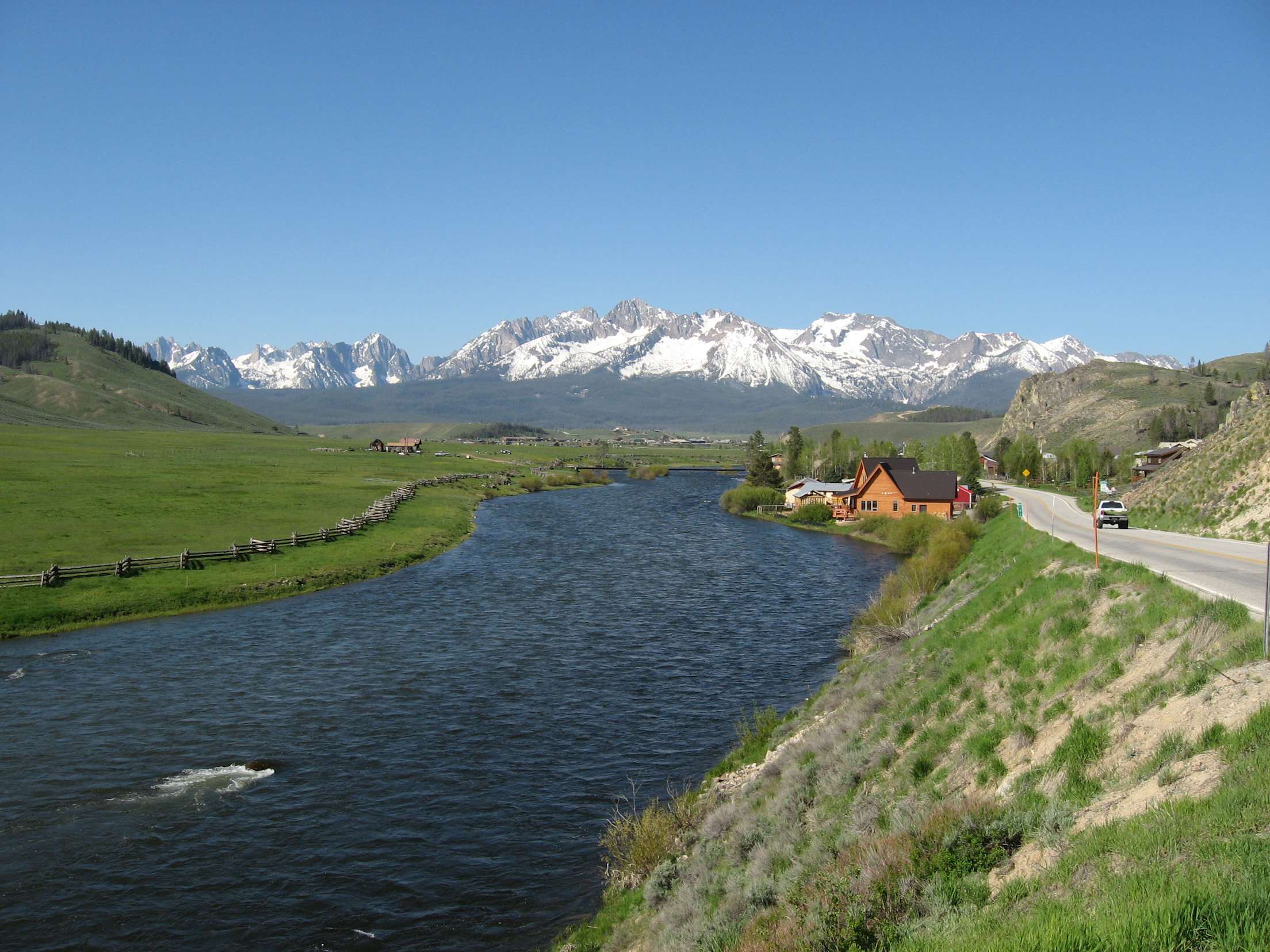
The four forks of the Salmon River run through some beautiful, rugged country in Idaho.
Salmon River in Stanley, Idaho
An hour north of Sun Valley, the Salmon River brings in resort crowds, families, and anyone who enjoys a good day on the water. Summer sees a stream of rafters enter the cool flow just downstream from Stanley. From there, it’s a short ride to the Piece of Cake rapids and the Narrows, where the river squeezes through a steep canyon of dark rock. After that, it flattens out and opens up for mellow drifting or a quick swim. The longest free-flowing river in Idaho—425 miles without a dam—the Salmon earned the nickname “River of No Return” because old-time boats, no match for the current, could travel only one way: downstream. But every June, chinook make a mockery of the moniker by fighting upstream to return to their birthplace near Stanley. When runs are strong enough, you can cast for salmon right at the edge of town. But salmon almost seem secondary on a river with so much else to offer: views of the jagged White Cloud Range, rainbow and cutthroat trout eager to rise to a well-presented fly, and riverside hot springs that ease the chill of mountain mornings. After you’ve floated, fished, or just soaked in the scenery, it will feel more like the River of Really Want to Return—the sooner the better.
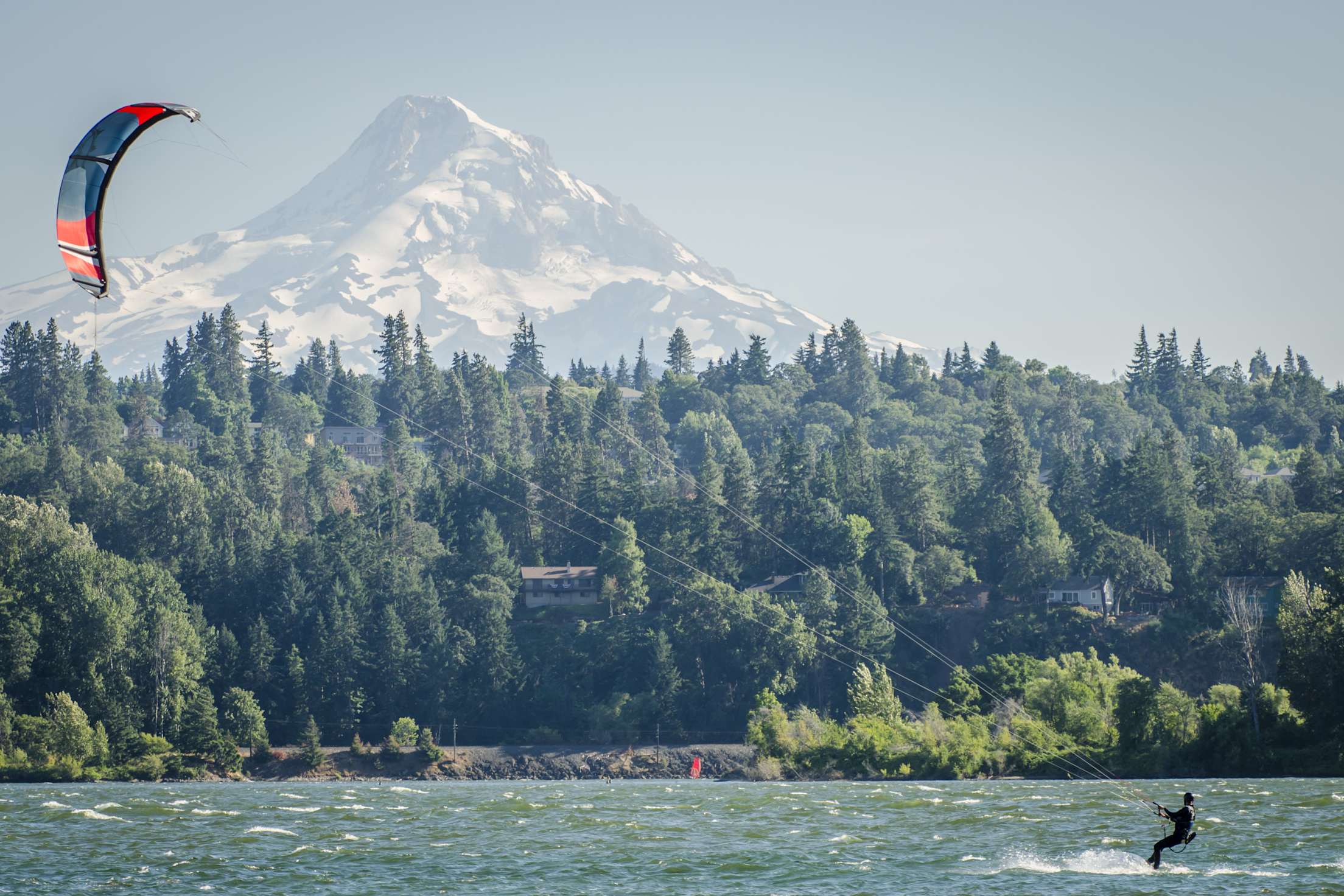
Pleasant breezes often keep the waterfront of Hood River, Oregon, busy with boats and kitesurfers.
Columbia River at Hood River, Oregon
The greatest river in the great Northwest rolls past many communities on its way to the Pacific, but the town of Hood River stands out. As much as this town loves its apples, pears, and wine, it also loves the water. The Bonneville Lock and Dam downstream keeps the river here broad, calm, and quiet, but there’s never a shortage of energy. On any sunny day, Hood River Waterfront Park buzzes with activity. When the breeze is right, crowds of windsurfers and kiteboarders bounce across whitecaps, showing off colorful sails, acrobatic jumps, and spectacular wipeouts. If you’re the adventurous type, sign up for a two- or three-hour windsurfing lesson with Hood River WaterPlay. On calmer days stand-up paddleboarders take to the water. The river, nearly a mile wide from bank to bank, also attracts anglers in search of salmon, sturgeon, and smallmouth bass. After a day on the water, many parkgoers head across the street for a chorizo, bacon, and mozzarella pizza at Solstice Wood Fire Cafe & Bar, a glass of Belgian-style beer at pFriem Family Brewers, or a David Bowie (award-winning Mt. Hood Vodka and passionfruit) paired with a tasty cheese board at Camp 1805 Distillery. With stunning Mount Hood in the background and the waterfalls and cliffs of the Columbia Gorge just downriver, the town of Hood River boasts scenery for miles. But there’s one view that locals cherish most of all: the big river, flowing through summer.
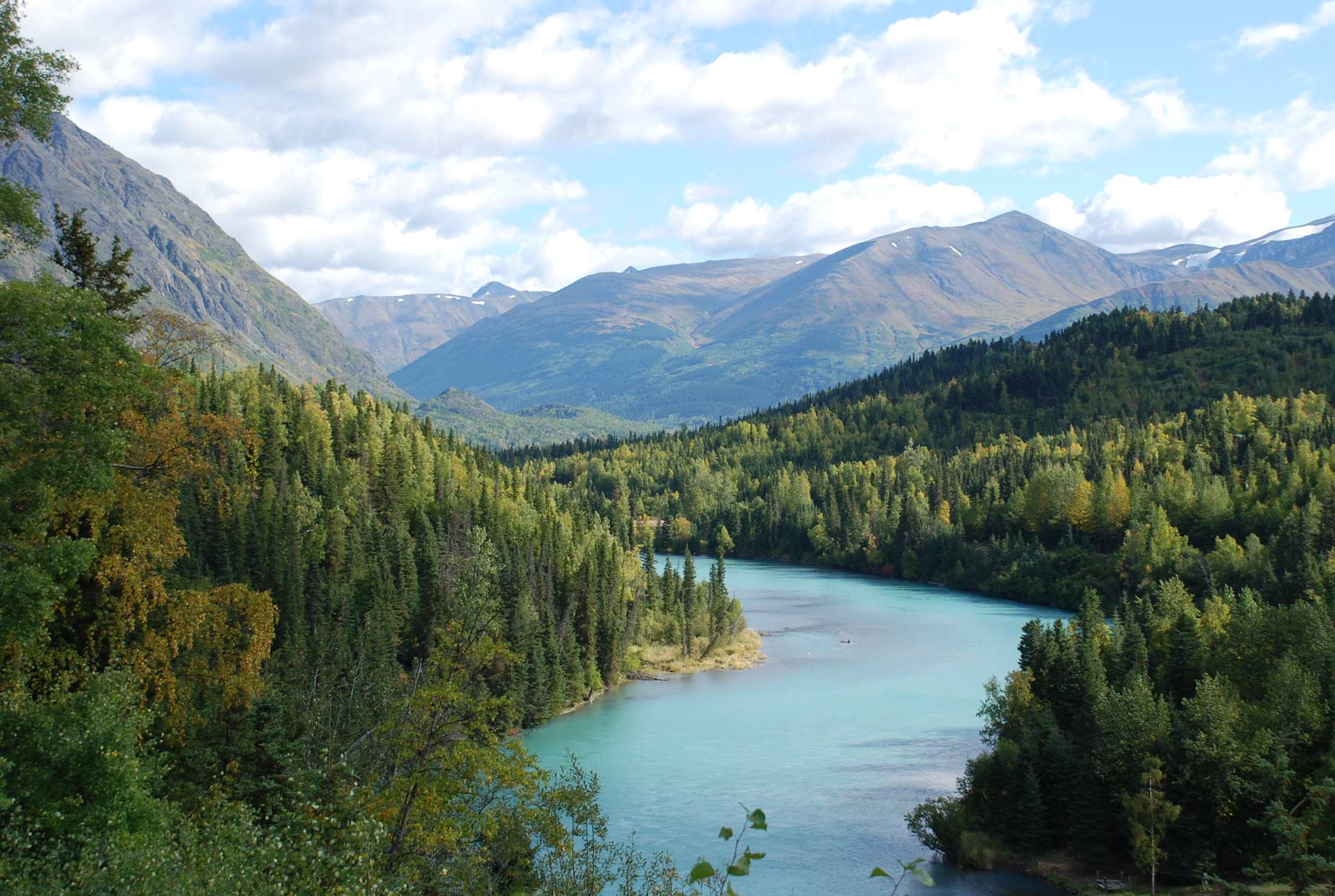
Glacial sediment in Alaska's Kenai River reflects green light, turning blue water turquoise.
Kenai River at Kenai, Alaska
At the point where the Kenai River ends its 82-mile course from Kenai Lake to the Cook Inlet, freshwater collides with the sea and an explosion of life enthralls nature lovers. In summer, harbor seals cruise the river mouth, caribou graze in the Kenai River Flats, moose browse the marshy banks, and occasional brown bears fish the shallows. Here the river—turquoise from the sediment of far-off glaciers that feed into the lake—runs flat, slow, and quiet, giving returning salmon a gentle reintroduction to the world of freshwater. These last few miles swell during high tide, creating enough room for some surprising visitors. In spring and fall, snow-white beluga whales swim several miles upstream hunting salmon and smelts, putting on a show for spectators. The Kenai City Beach, a stretch of fine sand with even finer views of the Alaska Range, makes a good place to watch for whales and other salmon hunters, including locals who jab for fish with long dip nets. As the tide rolls out, greater yellowlegs, dowitchers, sandpipers, and other shorebirds move in to muck about for a meal. Get a bird’s-eye view of the action from Erik Hansen Scout Park, atop a steep bluff overlooking the river. Migrating salmon splash in the water below, and a few thousand gulls squawk along the shore. The Kenai achieves that rare feat: It’s at its most lively at the very end. We should all be so lucky.
Missouri River in Great Falls, Montana
While gazing at the mighty Missouri from the 10th Street Bridge in Great Falls, Montana, pause a moment to pity some visitors of the past. Meriwether Lewis, William Clark, and their Corps of Discovery arrived here in the summer of 1805 expecting a day-long route to the Rocky Mountains. The roar and spray of five waterfalls told them to think otherwise. Lewis gamely called the falls “the grandest sight,” but it took the explorers roughly a miserable month to haul their gear and supplies (including their canoes—on wheels) across more than 18 miles of rough country to reach calmer water. Dams have since tamed the river, but the four remaining falls—Black Eagle, Rainbow, Crooked, and Great Falls’s namesake, which tumbles nearly 90 feet over the edge of the Ryan Dam 10 miles downstream from town—still impress. The River’s Edge Trail, 50-plus miles of pavement and paths, lets cyclists, joggers, and hikers follow the Missouri as it passes through town and enters the rugged prairie to the northeast. The Lewis and Clark Interpretive Center—a 25,000-square-foot exhibit hall, theater, and activity room—presents the story of the river and the epic detour that first put it in the history books. The highlight: a full-scale panoramic sculpture of four Corps members dragging a loaded dugout canoe up a nearly vertical cliff. Next door to the center, more than 150 million gallons of water bubble up in a clear pool at Giant Springs State Park, sparkling as they tumble into the Missouri. Today the river is still a grand sight—it’s just a whole lot easier to navigate.
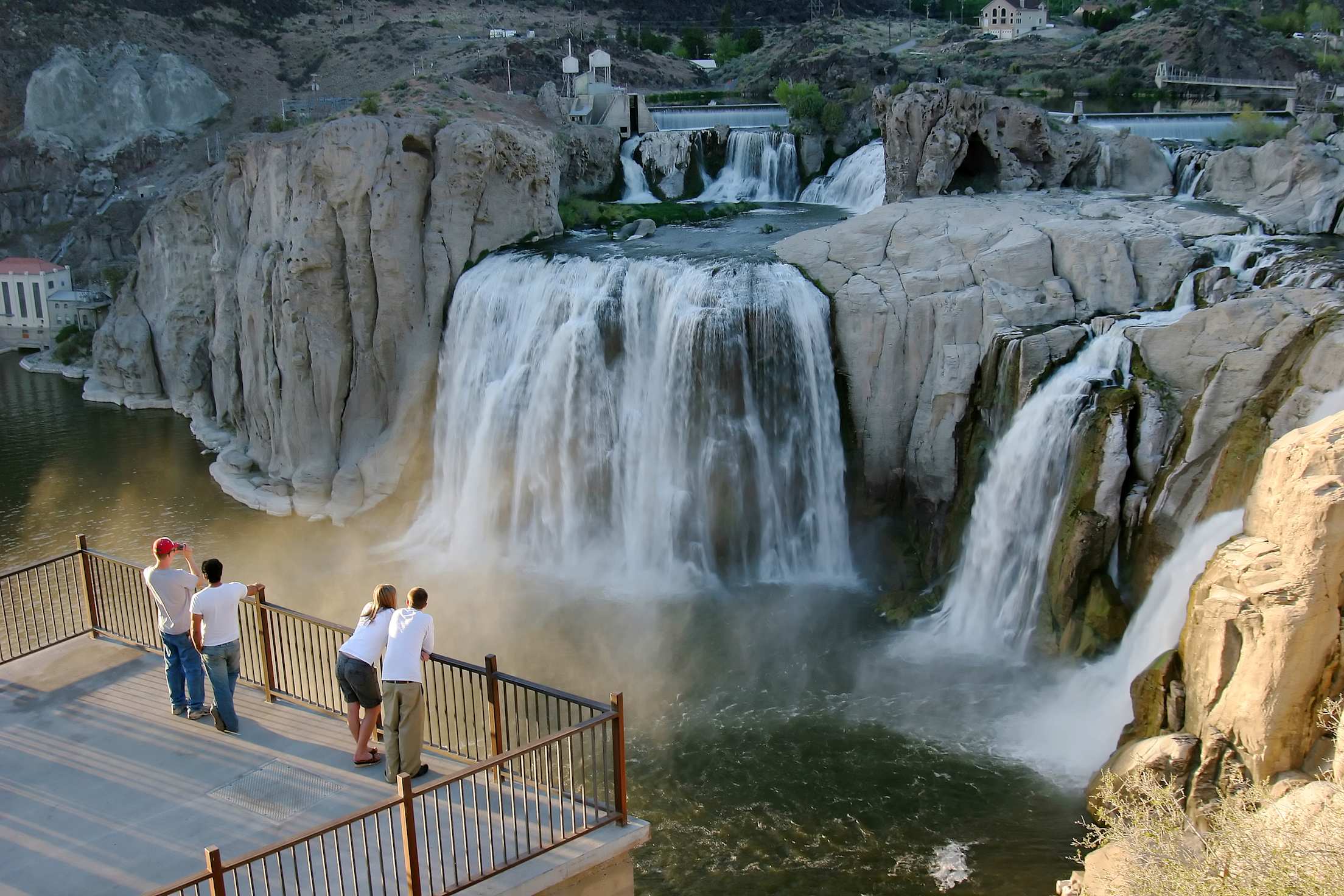
Shoshone Falls in Idaho's Snake River Canyon awes pedestrians and paddlers alike.
Snake River at Twin Falls, Idaho
Crashing waterfalls and soft sand, a placid river creeping through a wild canyon—the stretch of the Snake River near Twin Falls has something to offer thrill seekers, sunbathers, and everyone in between. Many folks dip in at Centennial Waterfront Park, an enclave of trees, shade, and picnic tables in the Idaho high desert. The current here is so gentle that kayakers and canoeists, whether plying their own crafts or rentals from Pryor Paddle in the park, travel upstream without much effort. Before long, they’re under the Perrine Bridge, a graceful 1,500-foot span connecting the sheer cliffs that form the Snake Canyon. In 1974, daredevil motorcyclist Evel Knievel tried to rocket his way across this canyon (and failed, though he survived); these days, a more common spectator treat is watching parachutists fling themselves off the bridge nearly 500 feet above the water. Beyond the Perrine, another mile of easy paddling leads to Pillar Falls, a set of rapids sloshing around monumental chunks of rock. Farther upstream, at Shoshone Falls, the Snake makes a 212-foot plunge at a gap in the rock nearly 1,000 feet wide. Visitors can take in the sight by driving to Shoshone Falls Park on the east end of town. The city’s namesake Twin Falls no longer lives up to its moniker since a hydroelectric project merged the pair into one cascade that gets skinny in summer. The falls of the Snake thunder in spring and whisper in late summer, but they’re always worth a look—and a listen.
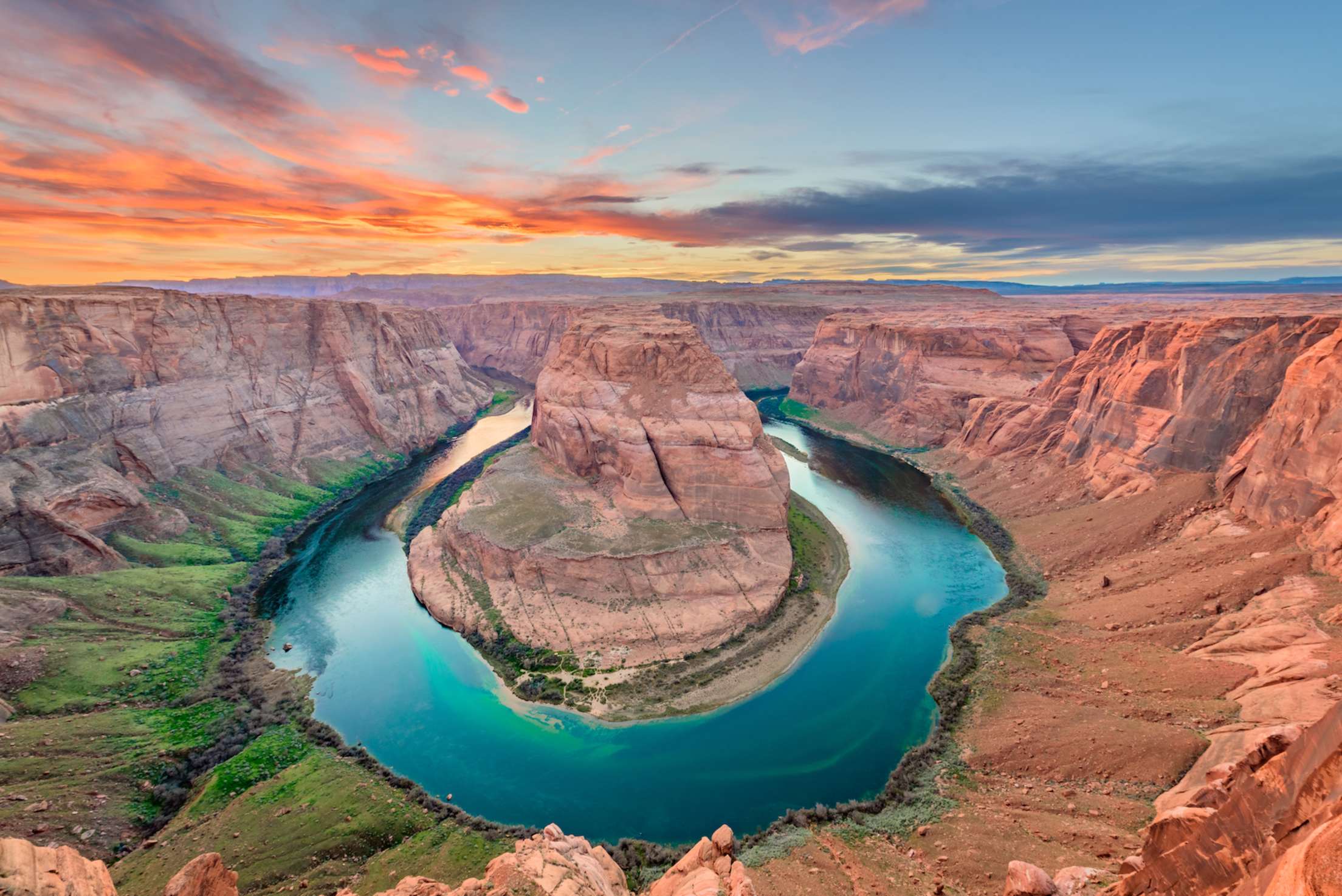
From above Horseshoe Bend, a few tiny boats reveal the scale of the Colorado.
Colorado River Near Page, Arizona
Epic seems a mild word for the Colorado, which touches parts of five states as well as the border between the United States and Mexico, supplies vast amounts of water to the West, and carved the Grand Canyon from the earth. Still, the river lives the peaceful life at Marble Canyon, by the massive Glen Canyon Dam. Founded in the 1950s as a work camp for the dam, the nearby town of Page, Arizona now celebrates its treasured waters. Rafts here are more likely to be helmed by vacationing families than by adventure seekers. Despite the calm waterway, the scene grabs the senses. The deep blue liquid, flowing cool and clear from Lake Powell, eases through Glen Canyon National Recreation Area, a red rock canyon that blazes with all the color of its more famous grand neighbor. Outdoors Unlimited offers rafting trips that are open to children as young as 10. When the river guide cuts the engine, passengers can take in the blissful quiet of the deep canyon, in which even the hum of a dragonfly or the whistling call of an osprey can startle. Just downstream from Page, the Colorado rolls through Horseshoe Bend, a nearly circular meander that skirts a large sandstone outcrop. An easy hike (just 0.75 mile) from Highway 89 takes you to an overlook offering amazing vistas from 1,000 feet above the water. North of the city, on the other side of the dam, vessels ranging from kayaks to houseboats drift around Lake Powell, the second-largest reservoir in the United States.
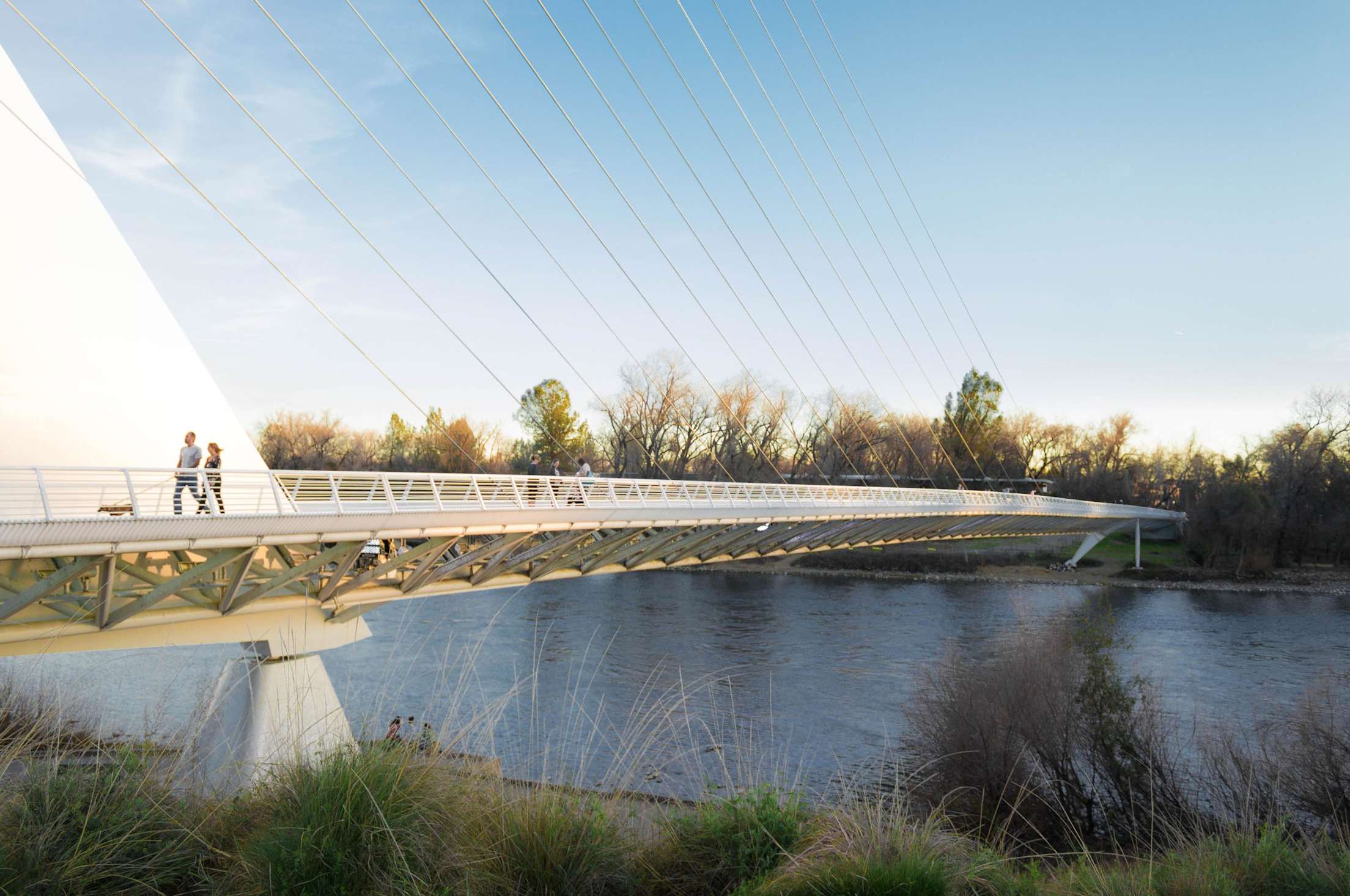
The Sundial Bridge on the Sacramento River tracks time with its shadow.
Sacramento River in Redding, California
In a state where water has become a scarce resource, the Sacramento is still the mother lode. Fed from the depths of Shasta Lake, California’s largest reservoir, the river at Redding stays big, burly, and cool even on a hot day in a dry year. The most popular—and elegant—vantage point is the Sundial Bridge, a gleaming walkway with a 217-foot pylon that really does track time with its shadow. But when you’re walking along the woodsy Sacramento River Trail or lingering in the botanical gardens at Turtle Bay Exploration Park, the exact hour won’t seem so important. The current looks quiet, but the river is roiling with life. Belted kingfishers perch on riverside branches, egrets and sandpipers work the shallows, ducks and geese paddle the eddies, and beavers and river otters show up daily for their bank jobs. Chinook salmon return here in fall, and the local rainbow trout stay as fat and happy in August as they are in April or January, creating year-round opportunities for fishing. Throughout summer, drift boats packed with anglers and rafts filled with families float past Redding’s office buildings, neighborhoods, and parks. Boat ramps at nearby Anderson and Balls Ferry provide the perfect endpoints for a short float past wetlands, cottonwoods, and vast swaths of blackberry bushes. Everywhere you look, you’re reminded of the deep value of water, and you’ll be grateful for a day of abundant wealth.